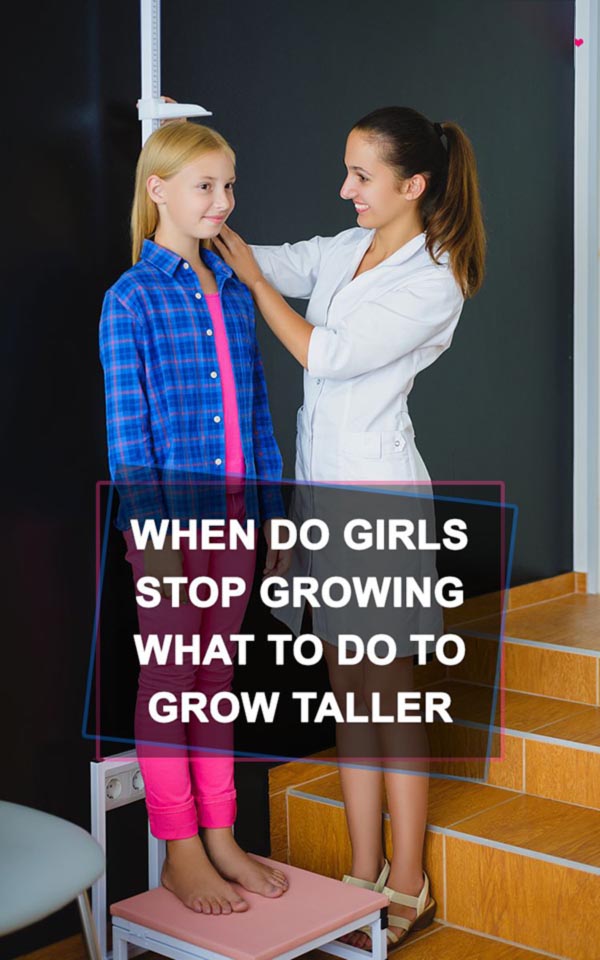At what age do you stop growing? You can drive a car at 16. You can vote in most countries at 18. You can legally buy alcohol at 21. But at what age can you no longer grow taller? People are unlikely to increase their height significantly after the ages of 18 to 20 even if they hit puberty late. Boys usually reach their peak height around the age of 16 while girls will have achieved their adult height by the time they are 15 years old. This article will go into detail about when a person’s height stops growing and which factors determine how tall they will become.
When do girls stop increasing height?
As girls go through puberty, they tend to experience a growth spurt that takes them to their final adult height in their teens. Puberty depicts a series of changes people go through as certain hormones increase to transform their bodies from a child into an adult. Girls typically start puberty between 10 and 14 years of age. Although puberty begins at a different time for everyone, the average age for girls to start puberty is approximately 11. Puberty can start earlier in some girls and it is completely normal. It is only atypical when a girl goes through puberty before the age of 8. Puberty can last until a person is about 16 years old.
The growth rate of girls reaches its peak 2 years after puberty begins. Once they start having menstruation, they usually gain around 3-4 inches in height. This height increase, however, can vary as girls who menstruate at an earlier age can often end up gaining more total inches of growth following the start of their periods. Most girls will have reached their final adult height by the age of 15 but as a person’s growth patterns are largely determined by genetics, there are a lot of variabilities when it comes to normal height or the perfect age to stop growing.

When do boys stop growing taller?
Puberty is the period in which boys grow the fastest. Some boys might not begin puberty until they are 15 while others may hit it as early as 9. Many boys experience the biggest growth spurt between the ages of 12 and 15. Similar to girls, puberty can last 2-5 years for boys, but spending less time in puberty does not necessarily mean that you will be shorter than someone who spends more time in it.
A majority of boys show only a slight increase in height after 18 years of age. For very few people, they may hit puberty in their late teens and continue growing until their early twenties. Besides, studies have discovered that men acquire peak muscle mass from 20 to 30 years old and our brain does not fully develop until the age of 25.

Why do we stop growing?
Funny as it might sound, we stop growing because we are genetically predetermined to do so. Our genes largely dictate how and how much we grow.
As our individual growing processes are controlled by our genetic codes, the purposes of continued physical growth are complete when our organs, bones, and reproductive systems have matured. The reproductive glands in both boys and girls will produce more estrogen hormone near the end of puberty. Such an increase of this hormone in the blood will lead to the fusion of the growth plates of our bones, thereby stopping growth and preventing the growth centers of our bones from responding to the hormones that initiate growth.
While most of us are unlikely to grow taller after the age of 20, some of our bones are still growing as we age. Our skull grows bigger with age, thus pulling our cheekbones farther back and shifting the forehead forward. Our pelvis also continues to widen over time. Between the ages of 20 and 79, the pelvic diameter increases roughly an inch on average, making the waist size larger by approximately 3 inches. There is a myth that our nose and ears never stop growing, but it is just an illusion. The changes in our nose and ears with age are simply caused by the deterioration of cartilage, which makes them sag and droop.

Which factors influence height growth?
The determinant role of genetics on how tall you will become is undeniable; yet, there are external factors that can impact a person’s growth to a great extent.
- Nutrition: Of all the external factors, nutrition is the most influential upon your height growth. Stunted growth is found among children and teenagers who do not get enough of one or more essential nutrients for height growth. A common nutrient deficiency that hinders maximal height growth is protein deficiency. Vitamin D, vitamin A, and mineral deficiencies also impact growth.
- Sleep: Growth hormone and thyroid-stimulating hormone are produced by your body when you are sleeping. Both of these hormones are crucial for the optimal development of your bones. For this reason, if you want to achieve your maximum height potential, try to get adequate sleep during your growing years.
- Exercise: Regular exercise has many benefits, including strengthening your bones and muscles, helping you maintain a healthy weight as well as promoting growth hormone production, all of which will contribute to your height growth.
- Health conditions: A variety of chronic or genetic conditions can result in stunted growth, namely Turner syndrome, Down syndrome, thyroid disease, achondroplasia, bone disease, and Russell-Silver syndrome. In addition, some stimulant medications used in treating attention deficit disorder may lead to delayed or stunted growth.
To sum up, all individuals grow at their own rates and patterns. However, not everyone can reach their maximum potential height. Without taking into consideration external factors that influence height such as nutrition, sleep, and exercise, it is difficult for people to achieve their genetically predetermined height, let alone surpassing it. As a result, before your growth plates fuse and you enter adulthood, try to lead a healthy lifestyle with a balanced and nutritious diet, regular exercise, sufficient sleep, and a safe living environment to facilitate optimal growth of both your physical and mental conditions.
